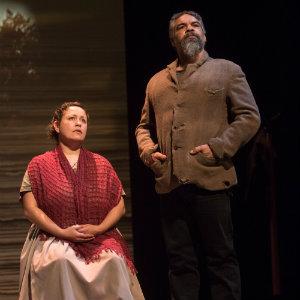The nine cast members began their presentation of no less than 19 witnesses and two commissioners by entering the active space painted on the stage floor out of costume. The four Aboriginal and five white cast members dressed themselves and set up the play’s wardrobe stock at the side of the stage’s active space. They also helped dress each other in station supply workers’ outfit fragments or contrasting ‘good-black’ clothes for the white legal authority figures. An extended pause which began the piece with the cast staring at the audience was an effective initial use of silence.
A mostly well-maintained pace saw the protagonists reveal the troubles, violence and corruption taking place on the station. Each testimony and tense set of answers from the station workers alternated with one of three of the white management figures who quickly indicated the many intersecting flaws of the attempts of the day to control the integration of white and black.
The fine speeches of the character William Black, played with poise by Kelton Pell, included the pointed words: “we are on Christian land, and should treat each other with brotherly love”. For a modern Australian or world, this resonates interestingly.
The characters of the inquiry’s commissioners are well-written and performed. One male and one historically significant female deliver a mixed bag of curiosity, empathy, sympathy, and scientifically shocking methods of labelling or addressing the Aboriginal people of the time. Not many contemporary audience members have heard the terms ‘real black’, ‘half-caste’ and ‘quadroon’ in the same elevated sentence. Especially uncomfortable was the idea of whether the ‘half-caste’ is more trustworthy or hardworking than a ‘full blood’ or other caste. The lines from Commissioner Ewan Hugh asking about the results of cross breeding for the benefit of the farm were as confronting to modern ears as they were wrong.
Coranderrk: We Will Show the Country is history that packs a punch. The playlist of quick-changing female characters and even an abused teenage boy illuminated by actor Melodie Reynolds-Diarra must be given special mention even amidst many penetrating performances.
Likewise, the work of the ‘full’ British whites, Irish, and other blends sharing several key roles and negotiating costume changes quickly was commendable. The theatrical use of the area outside the active stage square during various responses – almost Greek Chorus clapping or guffawing – added an effective dimension to the dialogue.
Ben Grant’s sound design brought well-chosen strumming to certain moments of intensity. The sound element developed as the tales led toward the full presentation of the Coranderrk workers’ petition. Only slightly on one occasion did this device compete a little too much with the dialogue. At all other times it was a worthy layer in the atmosphere.
Speaking of which, Darryl Cordell’s triptych backdrop with layered design in earthy tones was an evocative and useful tool in the presenting of the Coranderrk history. The changing projections were beautifully and aptly sequenced by AV designer Peter Worland. The use of a final slideshow with historic photography brought the reality of the drama home, suiting the production and dressing the emotions discovered in constricting 19th century clothing.
This play is an example of what can be achieved through cultural collaboration and blending the expertise of historians with a fine dramatic team. Find here the circumstance of humanity opened up before you.
4 stars out of 5
Coranderrk: We Will Show the Country
Concept: Giordano Nanni
Adaptation: Andrea James
Director: Isaac Drandic
Set Design: Darryl Cordell
Costume Design: Emily Barrie
Lighting Design: Blue Bottle
Cast: Syd Brisbane, Jim Daly, Peter Finlay, Greg Fryer, Liz Jones, Tom Long, Kelton Pell, Melodie Reynolds-Diarra and Jason Tamiru
The Playhouse, Sydney Opera House
June 28 – July 1





